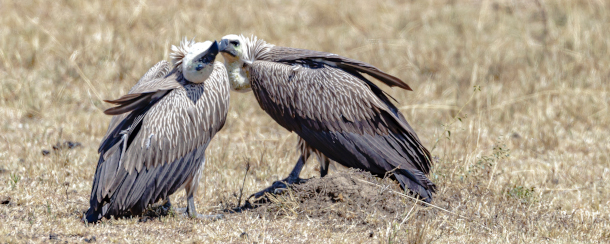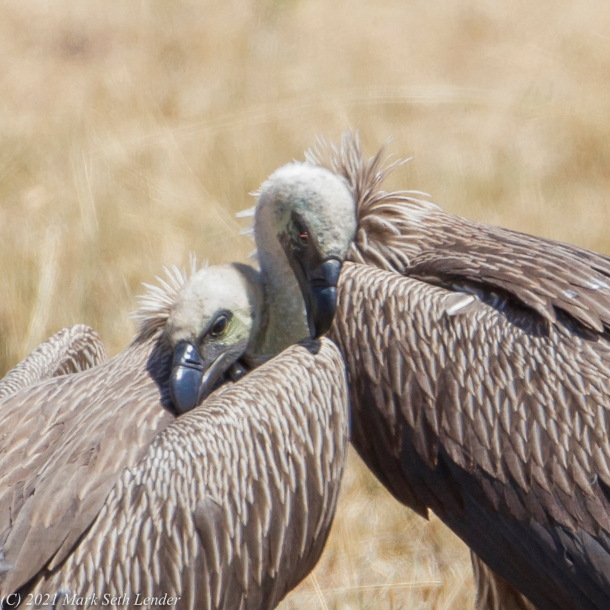Vultures in Love
Air Date: Week of October 29, 2021

Two vultures preen each other. (Photo: © Mark Seth Lender)
Vultures are not exactly the most charismatic or cuddly of animals but they do have their charm, observes Living on Earth’s Explorer in Residence, Mark Seth Lender. In East Africa, he watches a mated pair of vultures preening each other with ground termites to keep parasites at bay.
Transcript
CURWOOD: Vultures are not exactly the most charismatic or cuddly of animals but they do have their charm observes Living on Earth’s Explorer in Residence, Mark Seth Lender. In East Africa, he watched a mated pair of vultures preening each other with ground termites to keep parasites at bay.
"Vultures in Love"
White-backed Vulture
Near the Sekenani River, Maasai Mara
Author's Note
Some birds have an interesting use for ants or more likely, the formic acid ants themselves use as a defense. They sit on an ant hill with feathers spread and presumably the ants feast on the parasites feasting on the bird. Sometimes birds crush the ants onto their feathers and skin using the formic acid directly. Both practices are called anting. Another method for removing parasites is called allopreening, where one bird preens the feathers of another. Recorded here is an instance of African white-backed vultures combining both strategies – allopreening and anting - and not with ants but termites.
LENDER: Out on the open plain, two vultures stand side by side. The day is coming to an end (on at the equator night comes like a slammed door. Atop an acacia tree they would be out of harm’s way. Yet they remain. One of the vultures is on a small bare hummock that mounds up out of the close-cropped grass. The other bends down, and takes something from the base of the mound with the tip of his beak. The vulture on her slight perch does the same:
Bend.
Pick.
Up again.
Down again.
Now him…
Now her…
Now both of them.
Then:
Stropping brushing stroking each other with their beaks, rapid, intent, along the check, deep between the shoulders, burying their faces in the collar that forms a ruff about each other’s throats –
– rubbing something in.
The thing that each has retrieved from the mound?
There.
There it is.
Inside her open mouth.

Two vultures preen each other to keep parasites at bay. (Photo: © Mark Seth Lender))
The creamy white body of termite, bounced against the hard palate, the black tongue lifting pressing crushing. He has one also. And using their beaks like burnishing tools they spread the masticated stuff deep inside the many-layered coats of each other’s feathers.
And stop.
And look into each other’s jet black eyes.
Their mouths open, barely, as if speaking, as if his murmurings only for her, hers meant only for him.
And start again:
Combing roaming clutching.
Necks entwined.
Beaks touching.
And touching.
The light fails but they never will.
Vultures, in Love!
CURWOOD: Living on Earth’s Explorer in Residence, Mark Seth Lender
Links
Living on Earth wants to hear from you!
Living on Earth
62 Calef Highway, Suite 212
Lee, NH 03861
Telephone: 617-287-4121
E-mail: comments@loe.org
Newsletter [Click here]
Donate to Living on Earth!
Living on Earth is an independent media program and relies entirely on contributions from listeners and institutions supporting public service. Please donate now to preserve an independent environmental voice.
NewsletterLiving on Earth offers a weekly delivery of the show's rundown to your mailbox. Sign up for our newsletter today!
 Sailors For The Sea: Be the change you want to sea.
Sailors For The Sea: Be the change you want to sea.
 The Grantham Foundation for the Protection of the Environment: Committed to protecting and improving the health of the global environment.
The Grantham Foundation for the Protection of the Environment: Committed to protecting and improving the health of the global environment.
 Contribute to Living on Earth and receive, as our gift to you, an archival print of one of Mark Seth Lender's extraordinary wildlife photographs. Follow the link to see Mark's current collection of photographs.
Contribute to Living on Earth and receive, as our gift to you, an archival print of one of Mark Seth Lender's extraordinary wildlife photographs. Follow the link to see Mark's current collection of photographs.
 Buy a signed copy of Mark Seth Lender's book Smeagull the Seagull & support Living on Earth
Buy a signed copy of Mark Seth Lender's book Smeagull the Seagull & support Living on Earth

